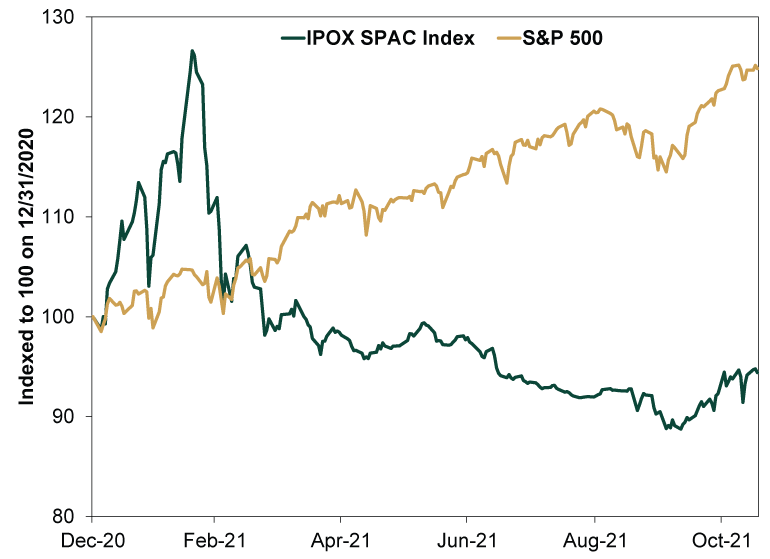Personal Wealth Management / Market Analysis
What Fear and Greed’s Tug of War Says About Sentiment Today
What does sentiment’s recent flip-flopping mean for investors?
What to make of sentiment today? After some areas of froth appeared to signal the return of investor ebullience mere weeks ago, the Omicron variant’s emergence has wiped away much of that renewed enthusiasm. This flipping-and-flopping could bewilder those following closely. But to us, sentiment’s recent seesawing highlights the importance of not overthinking near-term swings—moods can change quickly and don’t dictate where stocks head next. We think it is better to take a step back and view longer-term trends.
Before Omicron entered financial headlines, some pockets of euphoria from early this year returned to the spotlight. Interest in electric vehicle (EV) companies skyrocketed as investors hunted for the next Tesla—likely explaining why EV startup Lucid’s market cap topped Ford’s and GM’s despite just starting vehicle production in September.[i] In mid-November, another EV startup, Rivian, hit a market cap of around $153 billion—exceeding Volkswagen—making it the largest US company with zero revenue.[ii] Enthusiasm for cryptocurrencies resurged, too. After a summertime slump, bitcoin rebounded in the fall, with prices nearing $70,000 in November.[iii] That autumn climb had some crypto “experts” predicting bitcoin will reach $100,000 by yearend (for reference, its price is $57,229 as of December 1).[iv] That zeal has spread to anything seemingly attached to cryptocurrencies, with venture capitalists globally pouring more money into crypto and blockchain start-ups this year than the previous 10 years combined.[v] These developments had some investors starting to see froth—much like the pockets of excess that existed early this year in special-purpose acquisition companies (SPACs).
But then came the Omicron variant. US stocks suffered their worst Black Friday on record last week, and after Monday’s rebound, global markets slid again on Tuesday and Wednesday. Fear dots the financial pages, and a well-known chorus of worries returned to headlines. Will harsh COVID restrictions—or even lockdowns—come back? Are existing vaccines effective against the latest variant? Are central bankers removing their monetary “support” prematurely—especially after Fed chair Jerome Powell just suggested the Fed may wrap up its quantitative easing (QE) bond purchases more quickly than first thought?
So how should investors view these sentiment swings? In our view, take a step back: The vacillations in investors’ moods show sentiment is neither full-on frothy nor panic-stricken. Yes, we agree narrow segments of the market smacked of euphoria early in 2021. SPACs led the way at the start of the year before imploding, and EV startups seem to be cut from a similar cloth as other recent investing fads. But pockets of froth aren’t unusual during bull markets, and they don’t signal market peaks. See how SPACs have fared compared to broader markets this year. (Exhibit 1)
Exhibit 1: SPAC Euphoria Didn’t Make Its Way to Broader Markets

Source: Refinitiv and FactSet, as of 11/29/2021. IPOX SPAC ETF price and S&P 500 Price Index, 12/31/2020 – 11/17/2021. Both series indexed to 100 at 12/31/2020.
If euphoria had infected stocks broadly, we would expect to see broad equity indexes fall alongside the deflated categories. Yet those implosions remained largely confined to niche corners of the market.
Bitcoin’s resurgence strikes us as another sign euphoria isn’t here, counterintuitive as that may be. Early this year, bitcoin spiked as people hyped cryptocurrencies going mainstream as more companies added them to reserves and started taking them as payment. Now, bitcoin and other cryptos’ popularity seems at least partly tied to their purported powers as an inflation hedge. While we think that is wrongheaded—neither theory nor the limited available history support bitcoin as a useful inflation hedge—it is telling the impetus to own cryptos now stems from fear, not cheery anticipation about their future as money.
This tug-of-war between bulls and bears suggests neither greed nor fear dominates today. A host of sentiment metrics we track suggest moods have generally trended more optimistic lately: Initial public offering (IPO) activity has accelerated; consumer and fund manager sentiment surveys have perked up; and experts’ expectations for 2022 are mildly bullish (and, more notably, few major strategists are bearish). But investors going from feeling FOMO (fear of missing out) to just plain ol’ fear in mere days suggests sentiment isn’t overextended. In our view, sentiment can signal a turning point when nearly everyone is of one mind—and given sentiment’s recent vacillations, that doesn’t seem like the case today.
[i] “Lucid’s Market Cap Is Now Bigger Than Ford and GM,” Esha Dey, Bloomberg, 11/16/2021.
[ii] “Rivian Leaps Past Volkswagen’s Valuation as EV Mania Rages,” Esha Dey, Bloomberg, 11/6/2021.
[iii] Source: CoinMarketCap.com, as of 11/29/2021.
[iv] Ibid.
[v] “Venture Capital Funding for Crypto Companies Is Surging,” Ephrat Livni, The New York Times, 12/1/2021.
If you would like to contact the editors responsible for this article, please message MarketMinder directly.
*The content contained in this article represents only the opinions and viewpoints of the Fisher Investments editorial staff.
Get a weekly roundup of our market insights
Sign up for our weekly e-mail newsletter.

You Imagine Your Future. We Help You Get There.
Are you ready to start your journey to a better financial future?

Where Might the Market Go Next?
Confidently tackle the market’s ups and downs with independent research and analysis that tells you where we think stocks are headed—and why.





